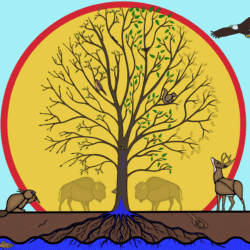The Tangled Garden – A Canadian Cultural Manifesto for the Digital Age, by R. Stursburg with S. Armstrong. James Lorimer and Co. Toronto, 2019; pp: ISBN 9781459413283
This is not a book about J. E. H. MacDonald’s iconic 1916 painting or about the garden (now restored) in the City of Vaughan that inspired it. Nor is this a book for those who think that the 1967 Centennial and the 1982 repatriation of the Constitution guaranteed a safe place for Canadian culture.
This is not a book about such national achievements, but about the failure of successive governments to protect the spirit and substance of our national identity in a globalized (i.e., Americanized) media world – resulting in a culturally tangled garden.
Authors Stursburg and Armstrong are quick to point out that, while performing arts, libraries, galleries, and museums are important components of Canadian culture, their interest in culture lies in the reproduceable and transmittable media – music, books, films, newspapers, and television – whose images and texts shape the values and identity of those who read and view the content.
For the authors, the content of these media defines our cultural identity and, ultimately, our political autonomy. Time and again, they remind us of the risk – if we, as Canadians, cannot see ourselves in our media, we will lose our national identity; if we are exposed only to American characters and scenes, we will be culturally annexed.
For those Canadians who came of age culturally in the Centennial period, this is not news but, driven by this premise, Stursburg and Armstrong take their readers on a truly frightening journey. It begins with the 1929 Aird Commission’s report on Canadian broadcasting, with its clear sense of how to manage distribution and content to protect national interests, through to today’s dystopian universe dominated by monster FAANGs (Facebook, Apple, Amazon, Netflix, and Google) with many scary scenes of government ineptitude along the way.
Stursburg, the lead author, has been a representative of the industry, a high-level federal bureaucrat and the head of English language CBC. He has been both a player and an inside observer for decades and he is not afraid to point fingers and name names. His chapter on Melanie Joly’s tenure as the Minister of Canadian Heritage (with responsibility for the media file) is a truly sobering story of incompetence in the face of what he would characterize as the gravest threat to Canadian identity ever.
The story that Stursburg and Armstrong tell runs its course through the policy initiatives, incentive programs, and regulatory tools of successive federal governments with chapters on the Mulroney, Chretien, Harper, and Justin Trudeau administrations. They identify both villains and unsung heroes. The authors also bear witness to the machinations within the industry as the smart money moves inexorably to convergence and cross-connection of the means of delivering content while, at the same time, show us how business models were changing overnight.
Following the book’s blow-by-blow descriptions of all the action in so many innings in this very long-running game, the “Manifesto” of the title, which rounds out the book, is a bit anti-climactic, feeling more like a summary. Yet, despite their many expressions of exasperation and anger over missed opportunities and bungling, and despite the complexities of the current situation, Stursburg and Armstrong still contend that we can take effective action using existing legislative tools – if we only have the will to do so.
This book is a late-in-the-day wake-up call and its main message deserves to be included in any serious public policy discussion, especially given the 2019 federal election campaign now underway. The outcome of the election and the next few years are likely to signal whether the will exists to better manage the evolution of this vital part of Canadian life.
This book is also an artifact of its time and it would not take much re-writing to turn this from a cultural story to a business story that is only about the battle for financial control of content and the channels of distribution. This is a world in which the numbers and dollars talk – according to the book, Netflix has 120 million subscribers – so the stakes are very high. And, even though, as Stursburg says, “content is king,” content is also servant to the machine and McLuhan’s aphorism about the medium being the message can, in this context, also be read as a warning.
Stursburg has spent a lot of time in the trenches of industry and government and it shows in his thorough understanding of the issues. He clearly believes that Canadians can use parts of the existing cultural apparatus to their advantage and claw back some of the money from the FAANGs for investment in Canadian culture. Few Canadians would not support this goal.
But there is a greater, unidentified context here and that is the character of life in the digital age and the need for all of us to be culturally engaged in our own lives and not just to be consumers of cultural products. While there is no question we need the increased investment in our cultural works, we also need a population that has cultural literacy and both the desire and the ability to seek meaning from their own narratives. Such a population would be “market ready” for all kinds of new expressions of our cultural identity.
In a quotation that could be both the beginning and ending for this book Stursburg and Armstrong provide an excerpt of a speech by Pierre Juneau, then head of CBC, to an audience at Harvard: “Our view is that culture is what a country says to itself, and about itself, to others whatever the technique of expression may be: theatre, film and television, novels, recorded entertainment, painting, architecture, or ballet. It is what make a people interesting, worthy of attention by the rest of the world. It is how people of a country express their dreams and hopes, and how they talk about their past and their future. It is what they care about.”
The type of ideal cultural garden aspired to by Juneau has become so overgrown with opportunistic and invasive species that Stursburg and Armstrong are right to want them all weeded out and to expect our federal government to be the head gardener. But, let’s remember too that the native species will also require good soil in order for the entire garden to thrive.


